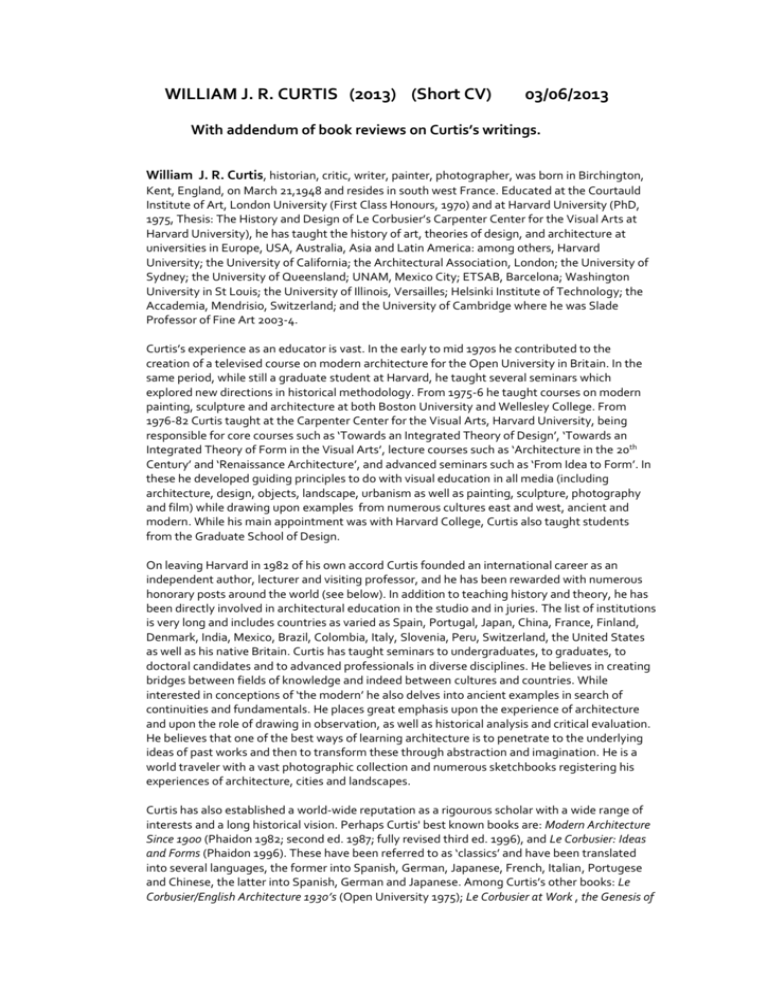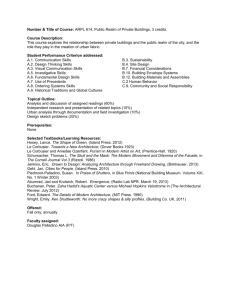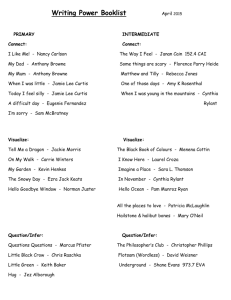Le Corbusier at Work, the Genesis of the Carpenter Center for the
advertisement

WILLIAM J. R. CURTIS (2013) (Short CV) 03/06/2013 With addendum of book reviews on Curtis’s writings. William J. R. Curtis, historian, critic, writer, painter, photographer, was born in Birchington, Kent, England, on March 21,1948 and resides in south west France. Educated at the Courtauld Institute of Art, London University (First Class Honours, 1970) and at Harvard University (PhD, 1975, Thesis: The History and Design of Le Corbusier’s Carpenter Center for the Visual Arts at Harvard University), he has taught the history of art, theories of design, and architecture at universities in Europe, USA, Australia, Asia and Latin America: among others, Harvard University; the University of California; the Architectural Association, London; the University of Sydney; the University of Queensland; UNAM, Mexico City; ETSAB, Barcelona; Washington University in St Louis; the University of Illinois, Versailles; Helsinki Institute of Technology; the Accademia, Mendrisio, Switzerland; and the University of Cambridge where he was Slade Professor of Fine Art 2003-4. Curtis’s experience as an educator is vast. In the early to mid 1970s he contributed to the creation of a televised course on modern architecture for the Open University in Britain. In the same period, while still a graduate student at Harvard, he taught several seminars which explored new directions in historical methodology. From 1975-6 he taught courses on modern painting, sculpture and architecture at both Boston University and Wellesley College. From 1976-82 Curtis taught at the Carpenter Center for the Visual Arts, Harvard University, being responsible for core courses such as ‘Towards an Integrated Theory of Design’, ‘Towards an Integrated Theory of Form in the Visual Arts’, lecture courses such as ‘Architecture in the 20th Century’ and ‘Renaissance Architecture’, and advanced seminars such as ‘From Idea to Form’. In these he developed guiding principles to do with visual education in all media (including architecture, design, objects, landscape, urbanism as well as painting, sculpture, photography and film) while drawing upon examples from numerous cultures east and west, ancient and modern. While his main appointment was with Harvard College, Curtis also taught students from the Graduate School of Design. On leaving Harvard in 1982 of his own accord Curtis founded an international career as an independent author, lecturer and visiting professor, and he has been rewarded with numerous honorary posts around the world (see below). In addition to teaching history and theory, he has been directly involved in architectural education in the studio and in juries. The list of institutions is very long and includes countries as varied as Spain, Portugal, Japan, China, France, Finland, Denmark, India, Mexico, Brazil, Colombia, Italy, Slovenia, Peru, Switzerland, the United States as well as his native Britain. Curtis has taught seminars to undergraduates, to graduates, to doctoral candidates and to advanced professionals in diverse disciplines. He believes in creating bridges between fields of knowledge and indeed between cultures and countries. While interested in conceptions of ‘the modern’ he also delves into ancient examples in search of continuities and fundamentals. He places great emphasis upon the experience of architecture and upon the role of drawing in observation, as well as historical analysis and critical evaluation. He believes that one of the best ways of learning architecture is to penetrate to the underlying ideas of past works and then to transform these through abstraction and imagination. He is a world traveler with a vast photographic collection and numerous sketchbooks registering his experiences of architecture, cities and landscapes. Curtis has also established a world-wide reputation as a rigourous scholar with a wide range of interests and a long historical vision. Perhaps Curtis' best known books are: Modern Architecture Since 1900 (Phaidon 1982; second ed. 1987; fully revised third ed. 1996), and Le Corbusier: Ideas and Forms (Phaidon 1996). These have been referred to as ‘classics’ and have been translated into several languages, the former into Spanish, German, Japanese, French, Italian, Portugese and Chinese, the latter into Spanish, German and Japanese. Among Curtis’s other books: Le Corbusier/English Architecture 1930’s (Open University 1975); Le Corbusier at Work , the Genesis of the Carpenter Center for the Visual Arts (Harvard 1978, ed. E.F. Sekler); Balkrishna Doshi: an Architecture for India (Mapin, Rizzoli 1989); Denys Lasdun: Architecture, City, Landscape (Phaidon, 1994). Curtis’s more recent books include: Abstractions in Space: Tadao Ando, Ellsworth Kelly, Richard Serra (Pulitzer Foundation, St. Louis 2001); Barcelona 1992-2004 (Gustavo Gili, Barcelona 2004); RCR Aranda , Pigem, Vilalta Arquitectes (Gustavo Gili, Barcelona 2004); La estructura de las sombras/ The Structure of Shadows, Bell-Lloc (Barcelona 2009) and Teodoro Gonzalez de Leon: Obra Completa/ Complete Works (Arquine, Mexico 2010). He contributed two texts to Edvard Ravnikar, Architect and Teacher (Springer, Vienna, NY, 2010), a book which received a Pleçnik Medal, in Ljubljana, Slovenia, April, 2010. Curtis also published introductions to numerous historical monographs, among recent ones: Alvar Aalto, Maison Louis Carré (Helsinki, 2008), Edvard Ravnikar, Architect and Teacher (Springer, Vienna 2009), Anant Raje Architect, Selected Works, 1971-2009 (Talika, New Delhi, 2012) and a major introductory essay in Fernando Tavora, Modernidade Permanente (Porto, 2012); Introduction ‘Lo Nuevo en lo Antiguo/The New in the Old’ in Vazquez Consuegra, Palacio de San Telmo, (Labirinto de Paxons, La Coruna, 2013).. Curtis has written historical, critical and theoretical texts on subjects as varied as modern architecture, landscape design, the history of everyday objects, the process of design, historiography, visual education, criticism, modern architecture in Spain, Indian architecture (modern and ancient), sub-Saharan vernacular architecture (see for example ‘Type and Variation, Berber Collective Dwellings of the North West Sahara, Muqarnas 1, Yale, 1983), Australian Aboriginal spear-throwers, photography, and the abstraction of nature in painting (see for example ‘Notes on Abstraction’, Mental Landscapes, Mielen Maisemia,( Alvar Aalto Academy, Helsinki, 2000) . Over the past forty years, Curtis has written over twenty texts on Le Corbusier in addition to his books on the subject – one could cite for example: ‘Le Corbusier, Manhattan et la Ville Radieuse’, Archithèse, 1976; ‘Ideas of Structure and the Structure of Ideas, Le Corbusier’s Pavillon Suisse, 1930-1’, JSAH, 1981; ‘Authenticity, Abstraction and the Ancient Sense’, Perspecta 20, Yale, 1983; ‘Le Corbusier, Nature and Tradition’, Le Corbusier, Architect of the Century, London, 1987; ‘Transformations’, Crossing the Parallel, Le Corbusier Mori Collection, Tokyo, 1999; ‘Abstractions et représentations; Le Capitole de Chandigarh, paysage de symboles’, Le Corbusier, L’atelier intérieur, Editions du Patrimoine, Paris, 2008; ‘Intersections: On Re-reading Le Corbusier’, AA Files, no 58, London, 2009. Curtis has produced over a dozen monographic studies on contemporary architects with El Croquis (Madrid) on (among others) Alvaro Siza, Rafael Moneo, Tadao Ando, Miralles /Pinos, Herzog & de Meuron, Juan Navarro Baldeweg, RCR Aranda Pigem Vilalta, the younger generation in Spain etc Curtis has also written introductions to a large number of major exhibition catalogues, for example Le Corbusier: Architect of the Century, London, Arts Council,1987; Finland Builds,, Museum Finnish Architecture, Helsinki, 1992; Bienal de arquitectura Espanola, Madrid (1995,1997); Alvar Aalto in Seven Buildings, MFA, Helsinki, 1998; Beyond Minimalism, The Architecture of Tadao Ando, Royal Academy, London, 1998; The Pritzker Architecture Prize, the First Twenty Years, Art Institute, Chicago, 1999); AAI Awards 2010, (Gandon Editions, Cork, Ireland 2011, Introductory text ‘The Time of Life, the Time of Architecture’); Louis Kahn, the Power of Architecture, Vitra Design Museum and Netherlands Architectural Institute, 2012, with the text ‘Modern Architecture and the Excavation of the Past, Louis I. Kahn and the Indian Sub-Continent’. Curtis is currently engaged in critical debates in the ‘third’ world as well as the ‘first’ and his writings on contemporary architecture have appeared in international journals such as Architectural Review, Architect's Journal, Architectural Record, L'Architecture d'aujourd'hui, ARK, D'Architectures, Plan Libre, Poïesis, Arkitektur DK, Arquitectura Viva, Il Giornale, dell 'architettura, Abitare, Bauwelt, Mimar, Arquine, Oris,A+U, Architecture+Design etc. and in weekly and daily newspapers such as El Païs, Lavanguardia ,The Guardian, NZ Zeitung and Building Design . His incisive analyses of contemporary architectural dilemmas have been translated into many languages including Chinese, Arabic, Galician, Basque and Hebrew. His carefully constructed and elegantly written book reviews in, for example, the Journal of Society of Architectural Historians or the Times Literary Supplement over the past thirty years are well enough known (one could cite ‘The Invention of the East, Myths of Indian Architecture’ TLS, August 1991; ‘Saying and Doing, Alberti’s Precepts and Practice’, TLS, March 1999; ‘Grammar of Earth’ Frank Lloyd Wright’, TLS, October, 2008). Curtis discusses his approach as a historian in ‘ La perspectiva de un historiador sobre la arquitectura moderna’, Conversa al voltant del llibre La arquitectura moderna desde 1900, William J. R. Curtis, Ed Cooperativa, COAC, Barcelona, 2007. He resumes his notions of criticism and his positions on recent architecture in ‘Ideas of Architecture and Architectural Ideas’ inThe Very Best Works at the Turn of the Century / Las Mejores Obras de Principios de Siglo (El Croquis, Madrid, September, 2011) and in ‘Maintaining the Long View, Notes on the Functions of Criticism’, ARK, February, 2013. Curtis has received several prizes and awards in recognition of his scholarship, his critical writings and his role as an educator, for example: the Founder's Award of the Society of Architectural Historians, USA, 1982 (for ‘Ideas of Structure and the Structure of Ideas: Le Corbusier’s Pavillon Suisse, 1930-31, JSAH, 1981); the Alice Davis Hitchcock Medal of the Society of Architectural Historians of Great Britain, 1984 (for Modern Architecture Since 1900, first edition, 1982); both the Book Award (for Modern Architecture Since 1900) and the Critic's Award of the Comité international des critiques d'architecture, 1985 (for ‘Principle versus Pastiche, Perspectives on Some Recent Classicisms’, Architectural Review, August, 1984); a Silver Medal at the World Architectural Biennale, 1989 (for Balkrishna Doshi, an Architecture for India, 1989); a Historical Monograph Award from the American Institute of Architects, 1997 (for Modern Architecture Since 1900, 3rd edition, 1996); a National Honor Society Gold Medal in Architecture and Allied Arts (USA), 1999 (for activities as historian, critic and educator); a Foundation Medal marking the 50th Anniversary of the Museum of Finnish Architecture 2006. Curtis has served on numerous international juries and commissions, for example: the. Festival of India, 1986; Aga Khan Award, 1986 (Technical Reviewer); Compton Verney Opera House Jury , 1988; Wolf Prize Jury, Israel, 1991; Shanghai Pudong Honorary Committee, 1992; Finland Builds Jury, Museum of Finnish Architecture , 1992; Consiglio Scientifico, Univ. Svizzera Italiana, Accademia, Mendrisio, 1995-7; Board of International Master's Programme, Otaniemi Institute, Helsinki 1995-8; President of Jury, Piranesi Prize, Slovenia 2000; Museum of Human Evolution Jury, Burgos, 2000; Premio Regional de Arquitectura Jury, Canaries, 2004; Port Tanger-Med Jury, Morocco 2005; Palais des Congrès Jury, Nancy 2007; Equerre d’Argent Jury, Paris 2007; Prix Midi-Pyrenées Jury, Toulouse 2007; Gare Maritime Tanger-Med Jury,Morocco 2007; Premio Andalucia de Arquitectura 2008; Centre d'Art La Cuisine, Nègrepelisse Jury, 2009; President of Jury, ASCER Ceramics Prize, Spain 2009 ; Architectural Association of Ireland, Jury, 2010; President of Jury, Piranesi Prize, 30th edition, 2012. Curtis has delivered numerous formal lecture series around the world and filled several honorary posts, for example: Architectural Association, London, 1979 (‘Interactions of Form and Meaning in the Work of Le Corbusier’, 9 lectures); AA, London, 1980 (‘American Architecture from the Civil War to the Depression’, 6 lectures); Power Lectures, Australia, 1981; Taiwan Association of Architects, 1984; UNAM, Mexico City (series of 12 lectures on Le Corbusier); Aga Khan Regionalism Seminar, Bangladesh 1985; Cordingley Lecture, University of Manchester, 1987; Mies van der Rohe Lectures, I.I.T. Chicago, 1987; Banister Fletcher Lectures, London, 1988; Inaugural Lecture, ETSAB, Barcelona, 1989; George Simpson Visiting Professorship, University of Edinburgh, 1990, 1991; Inaugural Lecture, ETSAM, Madrid 1990; End of Year Address,Technion, Haifa 1990; Alvar Aalto Symposium, 1991; Frank Llloyd Wright, Principles and Transformations, Taliesin West, Arizona, 1994; Berthold Lubetkin Memorial Lecture, 1995 ; Cycle de conférences, Societé française des architectes (SAFA), Paris, 1995 (22 lectures on the state of architecture); Univ. Archiprix, Utrecht 1997; Annual Sir John Soane Lecture, London, 1997 (on Modern Architecture and Ruins); Le Corbusier and Japan, Tokyo, 1997 (‘Le Corbusier as Mirror and Lens’); Le Corbusier, International, UNESCO, Paris 1997 (‘On Transforming Le Corbusier’); Chandigarh, Fifty Years of the Idea, Chandigarh, India,1999; East Wind, Tokyo, 2000; EAAE, Crete, 2000 -1. (continues below) Selected Formal Lectures (continued): Annual Lecture, Alvar Aalto Academy, Helsinki, 2002; Madrid 2012 Olympics, Madrid 2003; Utzon Symposium, Aalborg, 2003; Slade Professorship of Fine Art, University of Cambridge, 2003-4 (‘Modern Architecture and Monumentality’, 8 public lectures); Inaugural Lecture, Milan Polytechnic, 2006; Docomomo, London, 2006-7; Circulo de Bellas Artes, 2007;‘Presentacion, Spanish Ed Modern Architecture Since 1900, COAC, Barcelona 2007; UNAM, Mexico, 2007; Cycle de conferences: une perspective critique sur l’architecture contemporaine, SAFA, Paris, 2007 (6 lectures); Cité de l'architecture, Paris 2007; Rencontres des Causses de Quercy (Prehistoric Art), 2007; Eduardo Chillida: el Peine del Viento , San Sebastian, 2007; World Architecture Festival, Barcelona 2008.; Inaugural Lecture, Hay Literary Festival, Alhambra, 2009; Keynote Address, Mackintosh’s Masterpiece, Glasgow School of Art Centenary, 2009; Le Corbusier Voyage d’Orient, Middle Eastern Technical University, Ankara and Istituto Sturzo, Rome, 2011; Santiago de Compostela, 2011,2012; CCNY New York, 2011, 2012; Leccion Inaugural ETSA, Universitat Politecnica de Valencia, 2012; Akademie der Kunste, Berlin, 2012; Abstraccion y Luz, Grenada, 2012; Louis Kahn , The Space of Ideas, CCNY, 2013; Architecture and Meaning, RCA and V&A, London, 2013. Curtis has curated several exhibitions over the years and written accompanying catalogues/books/texts, among others: New Directions in British Architecture, (Courtauld Institute, London, 1969); Search for Total Construction, USSR 1917-32 (Carpenter Center for Visual Arts, Harvard, 1971) (contributions to catalogue); A Language and a Theme: the Architecture of Denys Lasdun and Partners (RIBA, Heinz Gallery, London 1976) (book of same name) ; Boston: Forty Years of Modern Architecture (Boston, Institute of Contemporary Arts, 1980) (book of same name); Fragments of Invention : the Sketchbooks of Le Corbusier (Carpenter Center for the Visual Arts, Harvard 1981; Design Museum, NY 1982; Hutheeseing Museum, Ahmedabad 1984; Museum, Chandigarh, 1985) (catalogue of same name, Architectural History Foundation and MIT Press). Forms and Functions of the Australian Aboriginal Spearthrower (Carpenter Center for the Visual Arts, Harvard 1982) (catalogue of same name). Modernism, Nature, Tradition : the Architecture of Denys Lasdun (European Investment Bank, Luxembourg 1995) (catalogue of same name). In addition Curtis has designed several exhibition installations of his own paintings and photographic work (see next paragraph). As well as writing books and critical essays, Curtis exhibits and publishes his paintings, drawings, reliefs and photographs. An exhibition of his drawings and paintings entitled ‘ Mental Landscapes/ Mielen Maisemia’’ was shown at the Museum of Finnish Architecture, Helsinki in 2000 accompanied by the book Mental Landscapes, (Alvar Aalto Academy, 2000); another , entitled 'Pokrajine Duha', took place at the Dessa Gallery, Ljubljana in 2001; a further selection, entitled ‘Mental Landscapes/ Paisajes Mentales’ was shown at the Circulo de Bellas Artes, Madrid in 2002 accompanied by the book Mental Landscapes/ Paisajes Mentales William J.R. Curtis, (Circulo de Bellas Artes, Madrid, 2002); yet another took place at the Carpenter Center for the Visual Arts, Harvard University in 2004, with a brief catalogue/flier. An exhibition of Curtis’s architectural photographs, 'Architectures du Monde .Le regard de William J.R. Curtis', took place at the Centre Méridional de l’Architecture et de la Ville in Toulouse in 2004-5; at the Forum d’Urbanisme et d’Architecture in Nice, summer 2005 and at the Maison de l’Architecture, Angers, 2011. A further exhibition with catalogue Structures of Light (Alvar Aalto Academy, 2007) took place at the Alvar Aalto Museum, Jyvaskyla, OctoberNovember 2007 (installation designed by author) http://www.alvaraalto.fi/info/press/07eng_studio-curtis.htm Curtis is currently preparing an exhibition of his paintings and drawings for IVAM (the Instituto Valenciano de Arte Moderno), Valencia, Spain with the title ‘Spaces of the Mind’ scheduled for 2013. He is in turn preparing an exhibition, principally of his photographs, for the Alhambra, Grenada, Spain, to be shown in the Palace of Charles V in summer 2014 with the provisional title ‘Mirrors of the Imagination’. WJRC 2013 03/06/2013 WILLIAM J. R. CURTIS: SELECTION OF BOOK REVIEWS. (Covering period up to 1997; for 1997-2013 see later file) Le Corbusier at Work, the Genesis of the Carpenter Center for the Visual Arts, (Cambridge, Mass., Harvard University Press, 1978. Editor, E.F. Sekler). Curtis was responsible for ‘Description of the Building’ pp 9-35, and the eleven chapter long ‘History of the Design’, pp 39-225. The book also contains essays by Eduard Sekler (‘Introduction’ and ‘Assessment’), by Rudolph Arnheim, and by Barbara Norfleet. For Curtis’s sections see above ‘Doctoral Thesis’, (accepted in 1975, written 1971-2). ‘The book reflects a level of scientific scholarship necessary to record and chart a masterpiece of modern architecture. Curtis sets a standard for Corbusian studies which may be difficult to follow . . . Tim Benton, Journal of Society of Architectural Historians, March 1980. ‘the book’s primary value, I believe lies in the area of documentation and description. By far the most convincing and interesting section of the book is Curtis’s largely descriptive ‘History of the Design’. Here an overall sense of the building’s conception and realization takes form’. Fred Koetter,Oppositions 19/20, New York, 1980. ‘What’s important about this book is . . .what it tells us about a great architect’s creative process, which is more than enough to make it a probable classic’. Robert Campbell, Boston Sunday Globe, September 3, 1978. ‘We are not likely to have a more complete record of the genesis of any building . . . No one interested in the origins of artistic creativity, the roots of 20th century architecture, or the mechanics of contemporary civilization should overlook this book’. Gerald W. R. Ward, Museum News, Washington D.C., February, 1979. ‘The book is a thoroughly researched history and assessment of the building, and it gives a welldocumented insight into Le Corbusier’s working methods . . . William Curtis’s masterful description of this process is backed by detailed notes, correspondence, and a bibliography . . . Reading Le Corbusier at Work is an experience second only to having participated in the project, and it must be acquired by all libraries with an interest in ‘architecture’. Choice, December, 1978. William Curtis, the primary contributor . . . has done a formidable job . . . there may be a chronological history to the design, but the meanings of the drawings are layered and simultaneous. Curtis interprets these multiple meanings with lucidity, and his interpretation elevates the close biography well beyond its constituent details . . . Curtis has clarified the content behind the forms, giving them a context in which they can be better understood’. Joseph Giovannini, Los Angeles Herald Examiner, August 22, 1979. ‘This book is quite different from all the other many books I have read by or about Le Corbusier and his work. It explains fully the whole structure of his ideology, his almost religiously held architectural beliefs . . . scrupulously honest, written in good English, (it) is the best book I have come across to instruct and illumine Le Corbusier’s work. Though it deals with only one building it does it with such thoroughness it would be my choice for students’. Jane Drew, R.I.B.A. Journal, London, March 1979. ‘It is a case-history of the most detailed kind . . . When a balanced biography of Le Corbusier comes to be written . . . this will be an invaluable source book. J. M. Richards, Times Literary Supplement, London, 1 February 1980. ‘un ouvrage qui pourrait, par son propos, la documentation qui l’accompagne, tant verbale que graphique, être considéré comme premier modèle d’une démarche à suivre pour une recherche architecturale systématique’. Philippe Boudon, AMC (Architecture Mouvement Continuité), Paris, December, 1979. Modern Architecture Since 1900,1st edition ,Phaidon Press, Oxford, 1982 2nd edition, Phaidon, Oxford, 1987; 3rd edition; Phaidon , London 1996. (3rd, fully revised with seven new chapters and numerous other changes, new notes, bibliography and design, 862 illustrations). (US college editions, Prentice-Hall, NJ; 3rd edition US non-college, Phaidon (Chronicle Books distributor). (1st edition, Spanish, La Arquitectura Moderna desde 1900, Hermann Blume, Madrid, 987; German, Architektur im 20 Jahrhundert, DVA, Stuttgart, 1989; Japanese, Kajima, Tokyo, 1990). 1st edition awarded the Alice David Hitchcock medallion by the Society of Architectural historians of Great Britain for making ‘an outstanding contribution to the study and knowledge of architectural history’. (October, 1984). Listed by the CICA (Comité International des Critiques d’architecture) as one of the five most significant books on architectural criticism to be published in the previous three years (January, 1985). ‘ . . . it is not only immeasurably the finest work covering this field in existence, first edition but may very well be the best survey of any field in the history of architecture written since the prime of Nikolaus Pevsner and Sigfried Giedion’. James Ackerman, Professor of Fine Arts, Harvard University, 1982. ‘ . . . the scope of the book is breath-taking, and so is the author’s versatility in the field of twentieth century architecture. With apparent ease, Curtis succeeds in translating an overwhelming bulk of knowledge into a fluent and never overloaded text. Given the quantity of precise information he handles, one is first edition amazed by the competence with which he controls his subject and by the brilliance with which he puts facts and arguments into interesting critical perspectives. Some of these chapters will set new standards in the historiography of modern architecture’. Stanislaus Von Moos, Art Journal, Summer 1983. In his treatment of regional developments the author deals with the question of authenticity most convincingly in connection with the architecture of the developing countries . . . the skill with which the author moves from chapter to chapter, from topic to topic, from idea to idea, gives the entire book a coherence and unity unrivalled in textbooks on the subject. . . . it is the meaning of buildings as exemplified by their social, institutional and, above all, cultural significance that occupies the author’s greatest attention . . .’ Peter Serenyi, Journal of Architectural Historians, October, 1984. ‘This is a distinguished and much needed book. It is distinguished for its critical insights and its theoretical force . . . Authenticity, the imaginative coherence of part and whole, of social vision and form, is his touchstone, and it rarely fails him’. Tom Heath, Architecture Australia, July, 1984. ‘His introduction is about as intelligent a summary of the problems of defining modern architecture as I have ever read . . .’ Martin Pawley,Architectural Review, December, 1983. ‘Curtis has made a conscientious effort to give a comprehensive account of the modern movement in architecture by filling in the gaps left by modernist rhetoric and omission; he clearly wants to tell the whole story with truth and justice for all. An able historian, he succeeds to a degree.’ Ada Louise Huxtable, New York Review of Books, 22 December, 1983. ‘. . . this triumphant survey . . . the prose is sometimes inspiring, sometimes funny, always interesting . . . this summary is tremendous. More concise and readable than Hitchcock, it deserves to become a classic’. Arts Review, 17 December, 1982. ‘. . . William J. R. Curtis deserves high praise for picking up and unravelling the strands of 75 years of architecture in such a remarkably well-balanced and lucid collection of essays’. Charles Knevitt, Sunday Telegraph, 27 February, 1983. ‘The chief virtue of William J. R. Curtis’ new book Modern Architecture Since 1900 is that Curtis is able to put the history of modern architecture in context and in perspective. Curtis understands better than most what goes into the making of architecture. . . . He shows that the best of modern work and the examples likely to live on through history are those that have a deep-seated sense of architectural values and that deal with fundamental issues of space, light and form.’ Brett Donham, Progressive Architecture, May, 1984 ‘For the non architect, the great value of the book is not only that it provides a lucid, swiftly informative overview, but also a basis for the critical evaluation of buildings . . . While Curtis mphasises form in his architectural analysis, he reads forms for their ideas . . . (he) looks for buildings that have philosophic intensity . . . Curtis stresses that the best of the modernists may have rejected historicism and revivalism, but that they did not reject tradition. Curtis notes repeatedly that such figures as Le Corbusier, Louis Kahn, Frank Lloyd Wright, even Mies van der Rohe, and many others, sought not the outward forms of classicism but its basic principles’. Joseph Giovanninni, Los Angeles Herald Examiner, 9 November 1982. ‘William Curtis’ new book Modern Architecture Since 1900 should prove a superb text for any course on modern architecture . . . can provide the student of architecture with the means to accomplish his most arduous task: to see’. Skyline, New York, April, 1983. ‘He handles . . . complex subjects in a remarkably clear and fluid prose, a welcome change from the dubious obscurantism of much current writing . . . Curtis’ strengths - an intuitive sense of the past, the intellectual agility to trace the complex course of style and influence, the acumen to disengage idea from form’. Douglas Suissman, Design Book Review, Spring, 1984. ‘The history of architecture is not a narration of events, its purpose is to give meaning to events in history. This can only be done if the historian takes up his work with crystalline clarity. This has been done by William Curtis by reiterating that good architecture is a matter of good judgement of form, clarity of function and something to raise the spirit of man to a sublime experience’. Aditya Prakash, Design (India), May 1983. ‘This will probably prove to be the definitive text on 20th century architecture: should you want only one book on the subject, this is it.’ Landscape Architecture, 1983 Curtis has history unfold in a number of gradually developing traditions. Individual works play a crucial role in these evolutionary processes. They transform and integrate latent tendencies into sensory experiences. Great masterpieces have an exemplary effect. They can end traditions, bend them and summon new ones into life. For Curtis, the assimilation, imitation and amendment of these works can explain more of architectural history than the verbal construction with which they are presented or criticised. He does not have modern architecture arising out of the polemics of the historic avant-gardes. And it is therefore not surprising that he is equally unimpressed by the diatribes which nowadays announce its demise. According to him, on the whole we are not at the end of an era or the beginning of a new one. We are in the middle of the multiform tradition of the modern . . . Hans van Dijk, ‘Dutch Modernism and It’s Legitimacy, Architectuur in NederlandJahrbock 1991-1992, Amsterdam, 1992. Modern Architecture Since 1900, 3rd edition. (Phaidon, London, 1996. ( Fully revised, seven new chapters and other changes, new design, footnotes, bibliography, 862 illustrations, many in colour). (Translated into French, Italian, Spanish,German, Portugese, Chinese). 3rd edition awarded Book Prize by American Institute of Architects, 2007. A book of this length and depth is an unimaginable achievement . . . each chapter opens with an excellent essay laying out the main theoretical and historical issues . . . some of the revised and additional sections, and his bibliographical notes, demonstrate that he listens to his critics. It is delightful to see good illustrations of great architecture by indigenous architects of the developing countries, to see social housing alongside public and private dwellings . . . Hard or soft back it is definitely worth having. Colour pictures are numerous and there are plenty you may not have seen before’. Emma Dent Coad, Building Design, London, 22 November 1996. ‘As close to a definitive guide to the architecture of our century as we yet have’. Hugh Pearman, Sunday Times, London, 1 December 1996. ‘This should be a standard volume in all architecture collections’. Library Journal, New York, 1 October 1996 ‘ . . . the latest, much expanded edition of his classic Modern Architecture Since 1900 . . . comprehensive, up-to-date and very readable’. Kenneth Powell, Sunday Telegraph, London, 8 December, 1996. ‘A classic survey that is by far the most comprehensive and intelligible of its kind . . . most remarkably he puts the work of contemporary architects into a historical perspective and brings his story up to date’. Michael Webb, L A Architect, September 1996. ‘ . . . this new edition of Curtis’ history . . . differs considerably in content as well as appearance . . . the most obvious difference is the addition of a new concluding section ‘Continuity and Change in the Late Twentieth Century’, where Curtis attempts that most difficult task for the historian - a judgment on the recent past . . . What remains constant, and give this history its strength, are two things in particular: the relatively extended treatment Curtis gives to certain key works, allowing him to develop his argument by attention to specifics and to explore several levels of meaning; and his marked distaste for ‘-isms’ in place of ‘authenticity’ . . . Andrew Mead, Architects’ Journal, London, 19 September, 1996. ‘Typically he combines the demonstration of general lines of development with a thorough description of the most emblematic examples, and it is this approach which Curtis uses in the last part (1980-1993). He rejects the usual labels and compares the situation to a delta in which the principal current divides into several streams . . . Spanish architecture has benefited greatly from the revision and amplification of this book . . . One cannot ask for more’. Jorge Sainz, Arquitectura Viva, Madrid, July-August, 1996. ‘Just as a whole range of literary history relies upon the pleasure of the text, Curtis’s architectural history relies upon the sheer joy of the built object. With a true gift of empathy he treats diverse examples, situating them in the context of the history of ideas and forms . . . a great book . . .’ Jean-Claude Garcias, L’Architecture d’aujourd’hui, Paris, December, 1996. ‘ Thanks to these interventions, Curtis’s work is probably the most complete handbook now available, taking serious consideration as it does of developments in the Third World. It is difficult to catch him out on an omission, whether in the architects mentioned or in the references to the literature consulted . . . Curtis has amply justified his standing as a historian, even in comparison with earlier authors of overviews such as Pevsner, Giedion, Zevi, Benevelo, Tafuri and Dal Co, Jencks and Frampton . . . Just the combination of main text and explanatory bibliography makes it an up-to-date handbook that hopefully will find its way on to the required reading list for all students of architecture and the history of art’. Hans van Dijk, Archis, Rotterdam, May-June 1997. Le Corbusier: Ideas and Forms (Phaidon Press, Oxford 1986, Rizzoli, New York, 1986). (Spanish edition, Le Corbusier, Ideas y Formas, Herman Blume, Madrid, 1987; German edition, Le Corbusier, Ideen und Formen, DVA, Stuttgart, 1987; Japanese edition, Kajima, 1992). ‘. . . the most lucid and complete chronicle yet available of Le Corbusier’s achievement and (in the words of his title) the ‘ideas and forms’ which successively and cumulatively account for its significance. It is, then, as incise narrative . . . illuminated by penetrating critical commentary that this book excels . . .‘ William H. Jordy, Times Literary Supplement, London, February 13, 1987. ‘. . . this book is an admirable as well as well-timed introduction to Le Corbusier. In it much recent scholarship has been pulled together and presented in a lively account of Le Corbusier’s life and work . . . it is also a record of personal observation and synthesis by an informed and shrewdly sensitive author which will remain valid and fresh in the long term.’ Peter Buchanan, Architectural Review, London April 1987. ‘William J.R. Curtis is the best architectural historian writing in the English language, and that alone makes this book something of an event. Unsurprisingly, Curtis has turned out what is probably the most comprehensive, well balanced and interesting narrative yet produced about one of the giants of 20th century architecture . . . ‘ Paul Gapp, Chicago Tribune, April 2, 1987. ‘. . . as a study of the life and work of possibly the most erudite, probably the most gifted, and certainly the most disturbing architect of the present century, it is unlikely to be superseded.’ James Palmes, The Architect, Royal Institute of British Architects’ Journal, London, April, 1987. ‘The most lucid and complete chronicle yet available of Le Corbusier’s achievement. This book excels’. Architecture, AIA American Institute of Architects’ Journal, Washington DC, March, 1987. ‘Surely one of the most thoughtful studies of the architect to emerge in recent years. Curtis’s book is part intellectual and artistic biography, part architectural history and criticism . . . a comprehensive portrait of the intellectual and spiritual obsessions that guided Le Corbusier’s work . . . Curtis seeks to reach behind the accumulated interpretive clichés and familiar formal devices of Le Corbusier’s architecture to the constant principles that animated his greatest work’. Roger Kimball, Architectural Record, New York, May, 1988. ‘. . . this would seem to be a good moment to recommend William Curtis’ excellent book on the great man. As far as I am concerned, this is not only the best single work on Le Corbusier - a model of scholarship, erudite yet eminently readable - it is also an invaluable analysis of the architectural creative process. It should be read and re-read by every student of architecture.’ David Wild, Building Design, London, October, 1987. ‘A carefully considered book, based on extensive thought and study of the vast documentation. Highly recommended.’ Library Journal, 15 March, 1987. ‘This book, by a leading architectural historian, is a valuable contribution to the study of the work of a complex architect whose major buildings are located in India. It brings into focus Le Corbusier’s ability to transform traditional architectural concepts without compromising modernity . . . ‘ Raj Rewal, Inside/Outside, New Delhi, January, 1988. ‘In this century of the birth of Le Corbusier . . . there have been dozens of books devoted to aspects of the master. Curtis’ is the best single volume introduction yet written’. Robert Campbell, Boston Globe, December 6, 1987. ‘This sympathetic handsomely illustrated biography . . . offers new perspectives’. Publishers’ Weekly, 24 October, 1986. ‘ . . . a well-balanced and handsome book . . . Curtis outlines the architect’s personal history, while tracing the development of his major motifs . . .’ The Print Collectors’ Newspaper, March-April, 1987. ‘ . . . architectural historian Curtis presents a close study of all the master’s major buildings, including - with the help of the doodles and sketches, some of which are published alongside the completed works - the themes that he drew upon for inspiration, and the ways in which he used these to create a new architectural vocabulary . . . a scrupulous study of his creative method.’ Interiors, May, 1987. ‘Curtis lets us see, through words and images, what Le Corbusier must have seen and felt . . . and in this way lets us speculate about the artist’s process of creation . . . For anyone who has created form, Curtis’ description of Le Corbusier’s creative process rings precisely true’. William Hubbard, Washington Times, Washington D.C., October, 1987. ‘Apart from insights into the deeper recesses of architectural creativity, Curtis punctuates his chronology with descriptive and analytical passages of individual buildings in a way which makes one look again at those one thought one knew quite well . . . Le Corbusier: Ideas and Forms is written in prose which throughout is a pleasure to read, highly evocative of place and clearly analytical of purpose.’ David Gray, AA Files 16, Architectural Association School of Architecture, London, 1988. ‘ . . . comme on aimerait que fût traduit le livre de William Curtis, Le Corbusier: Ideas and Forms (Phaidon éd.), le dernier en date, et sans doute le meilleur des grands livres sur l’architecte’. Pierre Vaisse, Figaro, La Vie Culturelle, Paris, 5 Novembre, 1987. Balkrishna Doshi: an Architecture for India (Mapin Press, Ahmedabad, 1988; US edition, Rizzoli, New York, 1988). Awarded Silver Medal at World Biennale of Architecture, Interarch, 1989. ‘In his book on Doshi, the author gives a picture not only of Doshi’s development as an architect but also of the philosophy motivating his work . . . the production of the book cannot be faulted. Excellent designing and printing . . . definitely worth buying, especially by students of architecture as for them it would be like a textbook. Very relevant to present-day India, this book is not only a tribute to the genius and vision of B. V. Doshi but has emerged as an extraordinary study of Indian architecture’. Sheila Mohan, Inside/Outside, Bombay, 1989. ‘This unique monograph about Doshi . . . includes biographical and bibliographical information. Curtis admires his subject and serves him well with an analytical portrait, a description of his world, and a critical discussion of his work. At present, when the Third World is being swamped by irrelevant building transplants, this is an important book for college and university architectural libraries’. Choice, July, 1989. ‘The book analyses each of the architect’s major projects and presents these in the form of sketches of ideas as well as photos of finished buildings . . . more than mere presentation, it examines ideas of culture, society and architecture as seen through an architect’s life work and diaries . . . it is Doshi’s quest for a regional architectural identity that is the most effective argument of the book . . . William Curtis, himself an acclaimed Western historian, is perhaps one of the few individuals in a position to write such a biography of Doshi - a book that raises the peculiarly Indian issues of architecture today . . .’ Gautam Bhatia, Express Magazine, New Delhi, April 1989. ‘. . . incisive, thorough and objective. It includes not only the necessary drawings but many of Doshi’s original sketches, which hint at his sources of inspiration. The photographs are excellent. A detailed bibliography and a catalogue of Doshi’s works completes the study . . . a superb book on the work of a talented architect’. Raj Saksena, Architecture, Washington D.C., October, 1989. ‘As William Curtis’s monograph shows, Doshi has versed himself in his own country’s philosophy and past as well as local forms and needs, and learned to apply the wisdom of the vernacular to modern materials and functions’. Architectural Record, New York, October, 1989. ‘After considerable research on Doshi’s notes, diaries, lectures, articles and other sources, Curtis has been able to extract the architect’s thoughts on various issues, grouping them thematically. The themes cut across chronology and indicate that Doshi has been preoccupied with certain issues for a long time . . . In a simple and lucid manner, Curtis tells the story of Doshi’s transformation from his early dependence on Le Corbusier and Louis Kahn to a more confident handling of a set of generic elements which have come to constitute his personal style’. Jaimini Mehta, Architecture and Design, New Delhi, Jan-Feb, 1989. Denys Lasdun: Architecture, City, Landscape, (Phaidon, London, 1994) (German edition, Denys Lasdun, Architektur, Stadt, Lundschaft, (Ernst und Sohn, Berlin, 1994). Elected architectural ‘book of the year’ for 1994 by Architects’ Journal, (London), also by Sunday Times, (London). ‘His book is one of the finest on architecture I have ever read. It is beautifully written, marshalling all the skills of a fine historian to set Lasdun’s buildings (and his important, under-rated writings) in the cultural climat e in which they were created, and yet taking the longer view as well’. Stephen Greenberg, Architects’ Journal, London, 1 June, 1994. ‘Sir Denys Lasdun is the greatest surviving English modernist, and at last we have a monograph worthy of the man . . . William Curtis . . . criticises as well as praises. He tries to make the book an architectural story with little on Lasdun’s private life. But it reads as a fine human drama all the same’. John Winter, Architectural Review, London, August, 1994. ‘The presentation of the cultural background from which the finished designs emerged is especially revealing, as there is a much greater preoccupation with the symbolic, poetic and intellectual qualities in the architecture than is immediately evident from photographs . . . The result is an impressive document, fluently written, judicious and perceptive, which certainly should win Lasdun new admirers’. Andrew Ballantyre, Times Literary Supplement, London, 2 October, 1994. ‘This book is a fine celebration and reappraisal of Lasdun’s work’. ‘Reviewers’ Choice’, The Observer, London, 15 May, 1994. ‘At last, a suitable birthday present for the man who has everything: this book must be sent to Prince Charles’. House and Garden, August, 1994. ‘ . . . a handsome and highly readable book. The author, William J.R. Curtis, argues convincingly the case for Lasdun as an architect whose work, though firmly rooted in the modern movement, has universal qualities and, more over, special relevance at a time when architects everywhere are searching for a new definition of ‘tradition.’ Kenneth Powell, Building Design, London, 3 June, 1994. ‘ . . . a well deserved tribute’. Interiors, August, 1994. ‘ . . . a thoughtful study’. The Independent, London, 25 May, 1994. ‘His book not only presents a portrait of Lasdun as one of the pioneers of post-war modernism in Britain, who helped transform the arid white modernism of the pre-war years into a richer, more humane style, but it also seems to suggest that there are still lessons for the new generation of architect to learn from Lasdun’s buildings’. Royal Institute of British Architects’ Journal, London, May, 1994. ‘The admitted intention of William Curtis’s well written and handsomely illustrated survey has been ‘to put the record straight.’ Fiona MacCarthy, The Observer, London, 8 May, 1994. ‘the best architecture book so far this year’. Hugh Pearman, Sunday Times, London, 10 July, 1994. END






